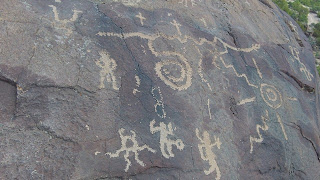The Art Spirit: Alive and Well in Taos
These are rocky times in the art business. The depression in sales is nation-wide (except at the very top where, allegedly, there’s more money than ever to shower on blue chip art), and its effect is especially severe in a little town like Taos where the economy is so linked to the art market. Sales here have been declining slowly but steadily for several years, and in just the past two months four prominent galleries have closed their doors. (Bucking the trend, Parks Gallery is doing just fine.)
Harwood Museum, Taos
The market will return, and in the meantime Taos’s art reputation is being maintained -- and even bolstered -- by two factors: activity in our remarkable museums and the persistence in the Taos Valley of what I’m still romantic enough to call the Art Spirit. The town has four fine museums -- Millicent Roger’s Museum, Taos Historic Museums, Taos Art Museum and the Harwood Museum which is perhaps the finest small town art museum in the nation. In the last few years the Harwood has mounted a number of exhibitions that have garnered national attention, including important shows of Richard Diebenkorn’s early New Mexico paintings, Wayne Thiebaud’s wonderful but seldom seen landscapes, and in 2006 a splendid survey of Melissa Zink’s art. Next year, the Harwood will present an exhibition of Agnes Martin’s early work that is sure to attract an international audience.
And Art Spirit. Taos has been home to world-class artists for more than a century. While the early Taos painters were attracted by the dramatic landscape, the richness and authenticity of the Pueblo Indian and Hispanic cultures and the quality of the fabled “Taos light,” contemporary artists whose work has nothing to do with mountains or Indians are still lured and held by the ineffable Art Spirit, the sum of all the factors above plus something in the air that nurtures creativity. Taos remains important because Ken Price, Larry Bell, the late Agnes Martin, Johnnie Winona Ross, Jack Smith, Marc Baseman, Ron Davis and a handful of others have chosen to call Taos home. Just their presence makes this an important place. For the most part they don’t exhibit here. Taos is home because it inspires them and leaves them alone to work. Price, one of America’s most honored contemporary artists, will have a major retrospective next year at the Los Angeles County Museum, a show that will go on to the Metropolitan Museum in New York. Bell currently has a 50-year retrospective at the Carre d’Art Musee in Niems, France.
Taos Pueblo.
The influential art critic Dave Hickey wrote an essay a few years ago for a Harwood exhibition that, for me, sums up what Taos is, if not why: “ . . . in my experience Taos is one of the most beautiful and chastening places in the world. It has an encouraging history of harboring fugitives, killing priests and assassinating governors. In the twentieth century, it has probably produced more serious art and literature than any other non-metropolitan area in the United States, and, throughout this century, Taos’ virtues have remained more amenable to producers of art than to its consumers. It has resisted gentrification because, for all its beauty, Taos is not a cozy place. There is not much that architecture or landscaping can do to mitigate the daunting hegemony of the sky, the sweep of the flat, the looming scale of the distant mountains, and the perpetual inference of D. H. Lawrence’s ghosts. Day in day out, year round, Taos is hardly even a human place. It is the Top of the World, more the Wild West than the Southwest---more Tibet, in fact, than Palm Springs. So if you want a beautiful place to work that bears with it the perpetual reminder that all you do will be broken, buried, blasted and blown away---a place that makes you brave and serious, Taos is the place for you.” (from “Dennis Hopper Curates - Larry Bell, Ron Cooper, Ronald Davis, Ken Price & Robert Dean Stockwell,” Harwood Museum, 2009)



